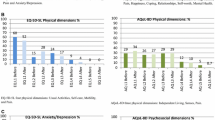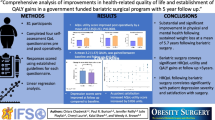Abstract
Background
Psychosocial health status is an important and dynamic outcome for bariatric/metabolic surgery patients, as acknowledged in recent international standardised outcomes reporting guidelines. Multi-attribute utility-instruments (MAUIs) capture and assess an individual’s health-related quality-of-life (HRQoL) within a single valuation, their utility. Neither MAUIs nor utilities were discussed in the guidelines. Many MAUIs (e.g. EQ-5D) target physical health. Not so the AQoL-8D.
Objectives
Our objective was to explore agreement between, and suitability of, the EQ-5D-5L and AQoL-8D for assessing health state utility, and to determine whether either MAUI could be preferentially recommended for metabolic/bariatric surgery patients.
Methods
Utilities for post-surgical private-sector patients (n = 33) were assessed using both instruments and summary statistics expressed as mean [standard deviation (SD)] and median [interquartile range (IQR)]. Interchangeability of the MAUIs was assessed with Bland–Altman analysis. Discriminatory attributes were investigated through floor/ceiling effects and dimension-to-dimension comparisons. Spearman’s rank measured associations between the instruments’ utility values and with the body mass index (BMI).
Results
Mean (SD) EQ-5D-5L utility value was 0.84 (0.15) and median 0.84 (IQR 0.75–1.00). Mean (SD) AQoL-8D utility value was 0.76 (0.17) and median 0.81 (IQR 0.63–0.88). Spearman’s rank was r = 0.68; (p < 0.001); however, Bland–Altman analysis revealed fundamental differences. Neither instrument gave rise to floor effects. A ceiling effect was observed with the EQ-5D-5L, with 36 % of participants obtaining a utility value of 1.00 (perfect health). These same participants obtained a mean utility of 0.87 on the AQoL-8D, primarily driven by the mental-super-dimension score (0.52).
Conclusions
The AQoL-8D preferentially captures psychosocial aspects of metabolic/bariatric surgery patients’ HRQoL. We recommend the AQoL-8D as a preferred MAUI for these patients given their complex physical/psychosocial needs.

Similar content being viewed by others
References
Gortmaker SL, Swinburn BA, Levy D, Carter R, Mabry PL, Finegood DT, et al. Changing the future of obesity: science, policy, and action. Lancet. 2011;378(9793):838–47.
Angrisani L, Santonicola A, Iovino P, Formisano G, Buchwald H, Scopinaro N. Bariatric surgery worldwide 2013. Obes Surg. 2015;25(10):1822–32.
Buchwald H, Oien DM. Metabolic/bariatric surgery worldwide 2011. Obes Surg. 2013;23(4):427–36.
Lindekilde N, Gladstone BP, Lübeck M, Nielsen J, Clausen L, Vach W, et al. The impact of bariatric surgery on quality of life: a systematic review and meta-analysis. Obes Rev. 2015;16(8):639–51.
Herpertz S, Müller A, Burgmer R, Crosby RD, de Zwaan M, Legenbauer T. Health-related quality of life and psychological functioning 9 years after restrictive surgical treatment for obesity. Surg Obes Relat Dis. 2015;11(6):1361–70. doi:10.1016/j.soard.04.008.
Karmali S. The impact of bariatric surgery on psychological health. J Obes. 2013. doi:10.1155/2013/837989 (Epub 28 Mar 2013).
Burgmer R, Legenbauer T, Müller A, de Zwaan M, Fischer C, Herpertz S. Psychological outcome 4 years after restrictive bariatric surgery. Obes Surg. 2014;24(10):1670–8.
Brethauer SA, Kim J, El Chaar M, Papasavas P, Eisenberg D, Rogers A, et al. Standardized outcomes reporting in metabolic and bariatric surgery. Surg Obes Rel Dis. 2015;11(3):489–506.
Brethauer S, Kim J, el Chaar M, Papasavas P, Eisenberg D, Rogers A, et al. Standardized outcomes reporting in metabolic and bariatric surgery. Obes Surg. 2015;25(4):587–606.
Khan MA, Richardson J, O’Brien P. The effect of obesity upon health related quality of life (HRQoL): a comparison of the AQoL-8D and SF-36 instruments. Farmeconomia Health Economics Therapeutic Pathways. 2012;13(2):69–82.
Drummond MF, Sculpher M, Torrance G, O’Brien B, Stoddart G. Methods for the economic evaluation of health care programmes. 3rd ed. New York: Oxford University Press; 2005.
Richardson J, Iezzi A, Khan MA, Maxwell A. Validity and reliability of the Assessment of Quality of Life (AQoL)-8D multi-attribute utility instrument. Patient. 2014;7(1):85–96.
Skinner EH, Denehy L, Warrillow S, Hawthorne G. Comparison of the measurement properties of the AQoL and SF-6D in critical illness. Critic Care Resusc. 2013;15(3):205.
Clarke PM, Hayes AJ, Glasziou PG, Scott R, Simes J, Keech AC. Using the EQ-5D index score as a predictor of outcomes in patients with type 2 diabetes. Med Care. 2009;47(1):61–8.
Richardson J, Iezzi A, Khan MA. Why do multi-attribute utility instruments produce different utilities: the relative importance of the descriptive systems, scale and ‘micro-utility’effects. Qual Life Res. 2015;24:1–9.
Chen G, Iezzi A, McKie J, Khan MA, Richardson J. Diabetes and quality of life: comparing results from utility instruments and Diabetes-39. Diabetes Res Clin Pract. 2015;109(2):326–33. doi:10.1016/j.diabres.2015.05.011.
Chen G, Khan MA, Iezzi A, Ratcliffe J, Richardson J. Mapping between 6 multiattribute utility instruments. Med Decis Making. 2015. doi:10.1177/0272989x15578127 (Epub 3 Apr 2015).
National Institute for Health and Care Excellence. Process and methods guides: guide to the methods for technology appraisal 2013. London: NICE; 2013. https://www.nice.org.uk/article/pmg9/resources/non-guidance-guide-to-the-methods-of-technology-appraisal-2013-pdf. Accessed 15 June 2015.
Richardson J, McKie J, Bariola E. Review and critique of health related multi attribute utility instruments. Melbourne: Monash University, Business and Economics, Centre for Health Economics; 2011.
Yang Y, Rowen D, Brazier J, Tsuchiya A, Young T, Longworth L. An exploratory study to test the impact on three “bolt-on” items to the EQ-5D. Value Health. 2015;18(1):52–60.
Lin F-J, Longworth L, Pickard AS. Evaluation of content on EQ-5D as compared to disease-specific utility measures. Qual Life Res. 2013;22(4):853–74.
Brazier J, Roberts J, Tsuchiya A, Busschbach J. A comparison of the EQ-5D and SF-6D across seven patient groups. Health Econ. 2004;13(9):873–84.
Herdman M, Gudex C, Lloyd A, Janssen M, Kind P, Parkin D, et al. Development and preliminary testing of the new five-level version of EQ-5D (EQ-5D-5L). Qual Life Res. 2011;20(10):1727–36.
Richardson. J. Increasing the sensitivity of the AQoL inventory for the evaluation of interventions affecting mental health. Melbourne: Monash University, Centre for Health Economics; 2011.
Holland R, Smith RD, Harvey I, Swift L, Lenaghan E. Assessing quality of life in the elderly: a direct comparison of the EQ-5D and AQoL. Health Econ. 2004;13(8):793–805.
Dolan P. Modeling valuations for EuroQol health states. Med Care. 1997;35(11):1095–108.
Richardson J, Sinha K, Iezzi A, Khan M. Modelling utility weights for the Assessment of Quality of Life (AQoL)-8D. Qual Life Res. 2014;23(8):2395–404.
Richardson J, Atherton Day N, Peacock S, Iezzi A. Measurement of the quality of life for economic evaluation and the Assessment of Quality of Life (AQoL) Mark 2 instrument. Aust. Econ Rev. 2004;37(1):62–88.
Jia Y, Cui F, Li L, Zhang D, Zhang G, Wang F, et al. Comparison between the EQ-5D-5L and the EQ-5D-3L in patients with hepatitis B. Qual Life Res. 2014;23(8):2355–63.
Janssen M, Pickard AS, Golicki D, Gudex C, Niewada M, Scalone L, et al. Measurement properties of the EQ-5D-5L compared to the EQ-5D-3L across eight patient groups: a multi-country study. Qual Life Res. 2013;22(7):1717–27.
Turner N, Campbell J, Peters TJ, Wiles N, Hollinghurst S. A comparison of four different approaches to measuring health utility in depressed patients. Health Qual Life Outcomes. 2013;11:81.
Culyer AJ. Encyclopaedia of Health Economics. 1st ed. : vol. 2. 1st ed. Oxford: Elsevier Science; 2014. p. 353.
Stevens KJ. How well do the generic multi-attribute utility iIncorporate patient and public views into their descriptive systems? Patient. 2015. doi:10.1007/s40271-015-0119-y (Epub 8 Feb 2015).
van Hout B, Janssen M, Feng Y-S, Kohlmann T, Busschbach J, Golicki D, et al. Interim scoring for the EQ-5D-5L: mapping the EQ-5D-5L to EQ-5D-3L value sets. Value Health. 2012;15(5):708–15.
Marra CA, Woolcott JC, Kopec JA, Shojania K, Offer R, Brazier JE, et al. A comparison of generic, indirect utility measures (the HUI2, HUI3, SF-6D, and the EQ-5D) and disease-specific instruments (the RAQoL and the HAQ) in rheumatoid arthritis. Soc Sci Med. 2005;60(7):1571–82.
Bland JM, Altman DG. Applying the right statistics: analyses of measurement studies. Ultrasound Obstet Gynecol. 2003;22(1):85–93.
Sullivan PW, Lawrence WF, Ghushchyan V. A national catalog of preference-based scores for chronic conditions in the United States. Med Care. 2005;43(7):736–49.
Cunillera O, Tresserras R, Rajmil L, Vilagut G, Brugulat P, Herdman M, et al. Discriminative capacity of the EQ-5D, SF-6D, and SF-12 as measures of health status in population health survey. Qual Life Res. 2010;19(6):853–64. doi:10.1007/s11136-010-9639-z.
Ribaric G, Buchwald JN, d’Orsay G, Daoud F. 3-year real-world outcomes with the Swedish adjustable gastric band in France. Obes Surg. 2013;23(2):184–96.
Ackroyd R, Mouiel J, Chevallier JM, Daoud F. Cost-effectiveness and budget impact of obesity surgery in patients with type-2 diabetes in three European countries. Obes Surg. 2006;16(11):1488–503.
Lin VW, Wong ES, Wright A, Flum DR, Garrison LP Jr, Alfonso-Cristancho R, et al. Association between health-related quality of life and body mass after adjustable gastric banding: a nonlinear approach. Value Health. 2013;16(5):823–9.
Pattanaphesaj J, Thavorncharoensap M. Measurement properties of the EQ-5D-5L compared to EQ-5D-3L in the Thai diabetes patients. Health Qual Life Outcomes. 2015;13(1):14. doi:10.1186/s12955-014-0203-3.
Pan C-W, Sun H-P, Wang X, Ma Q, Xu Y, Luo N, et al. The EQ-5D-5L index score is more discriminative than the EQ-5D-3L index score in diabetes patients. Qual Life Res. 2014;24(7):1767–74.
Yang F, Lau T, Lee E, Vathsala A, Chia KS, Luo N. Comparison of the preference-based EQ-5D-5L and SF-6D in patients with end-stage renal disease (ESRD). Eur J Health Econ. 2015;16(9):1019–26. doi:10.1007/s10198-014-0664-7.
Scalone L, Ciampichini R, Fagiuoli S, Gardini I, Fusco F, Gaeta L, et al. Comparing the performance of the standard EQ-5D 3L with the new version EQ-5D 5L in patients with chronic hepatic diseases. Qual Life Res. 2013;22(7):1707–16.
Tayyem R, Ali A, Atkinson J, Martin CR. Analysis of health-related quality-of-life instruments measuring the impact of bariatric surgery: systematic review of the instruments used and their content validity. Patient. 2011;4(2):73–87.
Tayyem R, Atkinson J, Martin C. Development and validation of a new bariatric-specific health-related quality of life instrument “bariatric and obesity-specific survey (BOSS)”. J Postgrad Med. 2014;60(4):357–61.
Mihalopoulos C, Chen G, Iezzi A, Khan MA, Richardson J. Assessing outcomes for cost-utility analysis in depression: comparison of five multi-attribute utility instruments with two depression-specific outcome measures. Br J Psychiatry. 2014;205(5):390–7.
Scalone L, Cortesi PA, Ciampichini R, Cesana G, Mantovani LG. Health related quality of life norm data of the Italian general population: results using the EQ-5D-3L and EQ-5D-5L instruments. Epidemiol Biostat Public Health. 2015;12(3):e11457-1-15.
Norman R, Cronin P, Viney R. A pilot discrete choice experiment to explore preferences for EQ-5D-5L health states. Appl Health Econ Health Policy. 2013;11(3):287–98.
Authorship
Julie Campbell contributed to study design, data verification and analysis, manuscript preparation and final approval. Andrew Palmer contributed to study design, manuscript review and final approval. Alison Venn contributed to study design, manuscript review and final approval. Melanie Sharman contributed to data collection and verification, manuscript review and final approval. Petr Otahal contributed to statistical analysis, manuscript review and final approval. Amanda Neil contributed to study design, data analysis, manuscript preparation and final approval. Amanda Neil is the overall guarantor of the submission.
Author information
Authors and Affiliations
Corresponding author
Ethics declarations
Disclosure of potential conflicts of interest
This work was supported by a National Health and Medical Research Council (NHMRC) Partnership Project Grant (APP1076899). AV is supported by a NHMRC Research Fellowship. AN is supported by a Select Foundation Research Fellowship.
Research involving human participants
Ethics approval was granted by the University of Tasmania’s Health and Medical Human Research Ethics Committees.
Informed consent
Informed consent was obtained from all individual participants included in the study.
Conflict of interest
The authors Julie A. Campbell, Andrew J. Palmer, Alison Venn, Melanie Sharman, Petr Otahal and Amanda Neil declare that they have no conflicts of interest.
Rights and permissions
About this article
Cite this article
Campbell, J.A., Palmer, A.J., Venn, A. et al. A Head-to-Head Comparison of the EQ-5D-5L and AQoL-8D Multi-Attribute Utility Instruments in Patients Who Have Previously Undergone Bariatric Surgery. Patient 9, 311–322 (2016). https://doi.org/10.1007/s40271-015-0157-5
Published:
Issue Date:
DOI: https://doi.org/10.1007/s40271-015-0157-5




